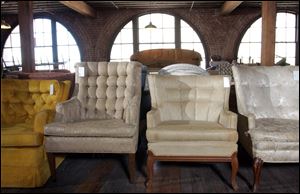
Young buyers seek high-quality vintage pieces to modernize
12/1/2013
Hundreds of chairs and sofas of different styles and time periods line the ‘road kill’ floor at Sit On It... A Chair Gallery in the West Bottoms district in Kansas City, Mo.
KANSAS CITY — Stephanie Grassie wandered into Sit on It … A Chair Gallery one morning and began browsing.
Grassie learned about the Kansas City, Mo., shop online after searching Yelp for furniture stores and finding a customer description that read, “It’s like art you can sit on.”
Shop owner Richelle Plett told Ms. Grassie that if she wanted to see what the studio was really about, she should head upstairs to the roadkill floor.
That’s where Ms. Plett stores hundreds of old sofas, chairs, ottomans, and other upholstered furniture that she has bought from yard, garage, and estate sales or — as the name implies — found abandoned and decrepit on the side of the road.
She rescues them and gives them some much-needed love.
Each piece has a price tag that indicates how much that love will cost the person who chooses it. Most sofas run around $800 in labor charges, while occasional chairs are about $450. That includes creating medium density cushions, installing Dacron and cotton batting, stabilizing the frame, hand-tying springs, and touching up exposed wood, Ms. Plett says. Fabric, which is often more than the cost of labor, is extra.
“I can’t find anything in stores that I like. This is unique, one-of-a-kind,” said Ms. Grassie, who is drawn to antique sofas and fabrics from India, as she looked around the first-floor gallery.
As it turns out, Ms. Grassie 30, of Weatherby Lake. Mo., represents a growing niche in the world of upholstery: Young clients interested in buying and reworking vintage furniture.
According to Ms. Plett, a lot of 40-somethings seem to prefer what she calls disposable furniture from big box retailers.
“People who grew up during the Reagan era, they’re like, ‘Oh let’s just get something new,’” she says. “But people 30 and under seem to realize that you can’t get the good stuff in those stores, and they feel a need to connect with previous generations. They walk in here, and it’s like walking into their grandparents’ homes. It’s nostalgic.
“They also can take it and personalize it, which is something you can’t get at Pottery Barn, where they offer various shades of beige,” she said.
Ms. Grassie added that there’s also “the whole sustainability factor. The idea that it’s not going to a landfill.”
Typically, a high-quality sofa or chair will have springs that have been hand-tied eight ways, tight webbing, and down cushioning. In low-quality furniture, cheap foam and thin wood substitute for those parts.
Ms. Plett keeps a new chair on hand in Sit on It, with pieces of fabric removed to expose the cardboard that shapes one of its arms and the lack of webbing on the back.
“That’s a no-no,” she said, pointing to the webbing. “Unless you were absolutely sentimental about this piece, it would be questionable as to whether it should be reupholstered.”
On the flip side, she has seen people with few or no upholstery skills take high-quality vintage pieces and redo them by putting new fabric on top of the old.
“Kudos to anyone who is re-covering an old piece, but it’s a short-term fix,” she says.
Sitting on furniture squishes the springs and puts tension on the twine that’s tying them together — a good thing because it keeps it all flexible, she says.
But people tend to store unused furniture in garages and basements, where lack of use and climate conditions dry out the twine. Also, the foam breaks down and becomes toxic. Eventually most of it needs to be torn off the frame and replaced.
Ms. Plett sometimes talks about her roadkill as if they’re alive.
“Every single one of these pieces has a story,” she said.
“They all have an energy about them. They’re like lost puppies happy to be found.”